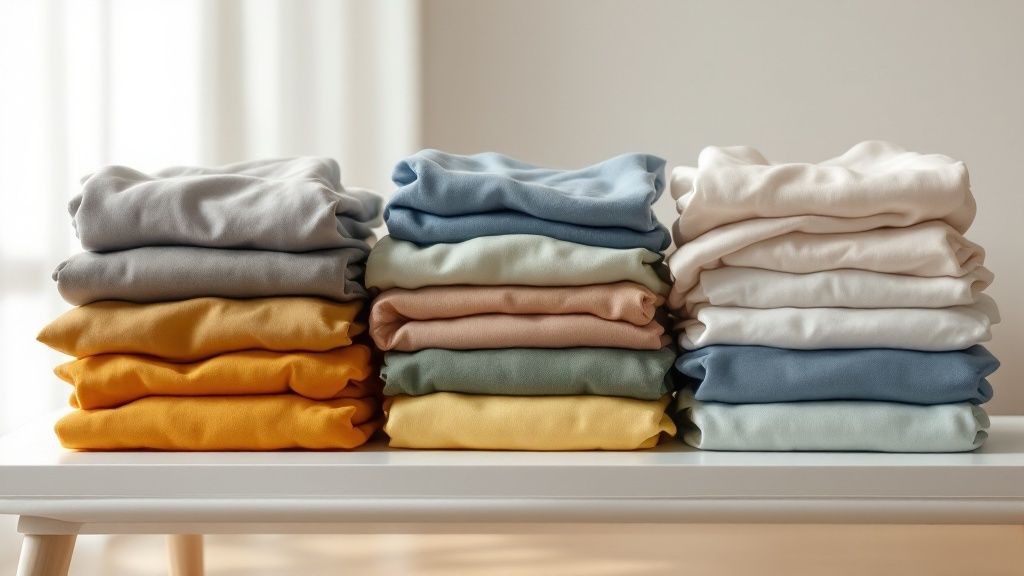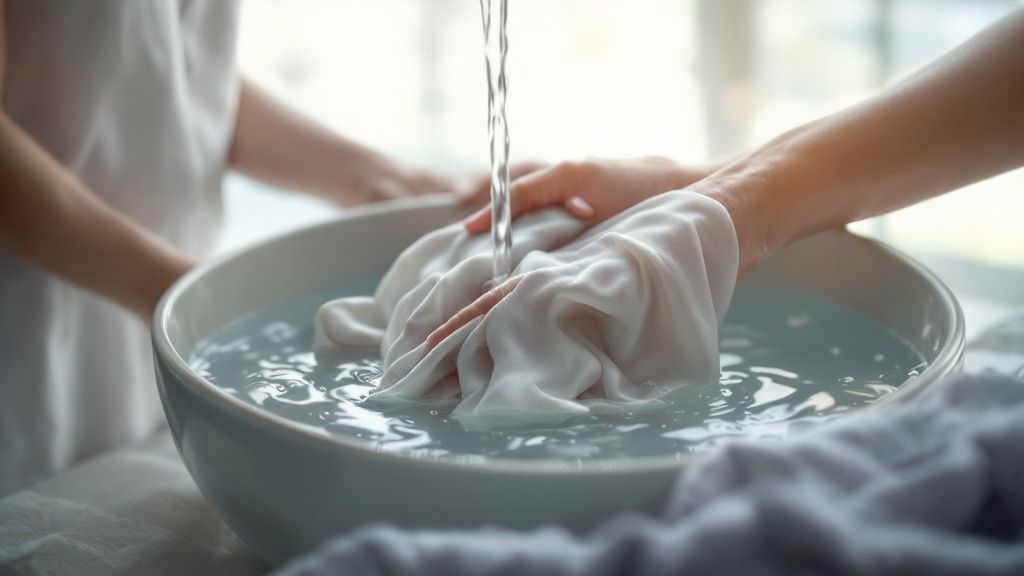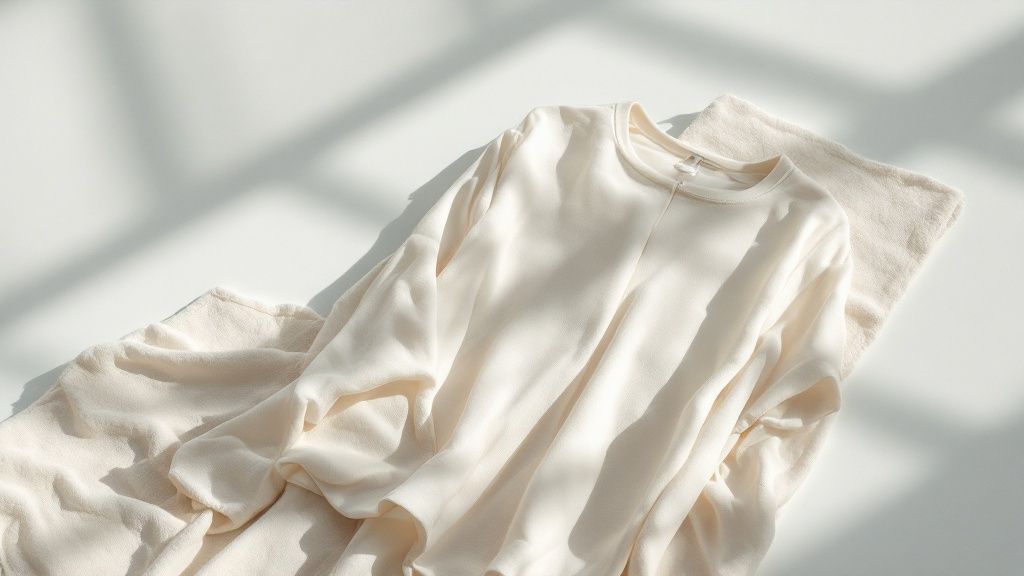Decoding Your Luxury Wardrobe's Hidden Language

That exquisite silk scarf or impeccably tailored cashmere coat represents a significant investment. Unlike your everyday clothes, these pieces demand a more thoughtful approach to care. Understanding the nuances of your luxury wardrobe—from fabric composition to construction techniques—is the key to preserving its value and longevity. This means knowing why caring for a silk blouse differs drastically from washing a simple cotton tee.
Fabric Composition: The Foundation of Care
Luxury garments often utilize premium, delicate materials like cashmere, silk, and merino wool. Each of these fibers possesses unique properties that require specific care instructions. Silk, a protein-based fiber, is particularly susceptible to damage from harsh detergents and high temperatures. Likewise, cashmere, prized for its softness, demands gentle handling to prevent pilling and shrinkage.
Knowing these inherent characteristics is crucial for proper cleaning. Many luxury items also incorporate intricate embellishments, such as beading or embroidery, which add another layer of complexity to the washing process. Protecting these details is essential to maintaining the garment's overall beauty.
Construction Techniques: More Than Meets the Eye
The construction of a luxury garment, beyond the fabric itself, plays a crucial role in its care. High-end pieces often feature hand-stitching, intricate seams, and delicate interfacing. These details, while contributing to the garment's overall quality and aesthetic, are easily damaged by improper washing.
Aggressive machine washing can disrupt delicate stitching, or cause the interfacing to shrink, altering the garment's shape. This meticulous attention to detail is a hallmark of luxury, distinguishing it from fast fashion and requiring a more considered cleaning approach. The global laundry care market reflects this trend, with consumers increasingly seeking effective and sustainable solutions.
The market is projected to reach $157.4 billion by 2033, a significant jump from its $95.7 billion valuation in 2023. This underscores a growing consumer focus on eco-friendly products and gentle care methods, especially for high-value clothing. For more insights, check out these statistics: Learn more about the growing laundry care market.
Deciphering Care Labels: No More Guesswork
Those often-cryptic symbols on care labels hold vital information for preserving your luxury garments. Understanding these symbols is paramount for effective cleaning. They provide specific instructions regarding washing temperature, drying methods, and ironing settings, tailored to the garment's unique fabric and construction.
Ignoring these instructions can result in irreversible damage, including shrinkage, color fading, or fabric distortion. Learning to decipher these symbols empowers you to confidently care for your investment pieces and avoid costly mistakes. This knowledge ensures your luxury items remain in pristine condition, allowing you to enjoy them for years to come.
Pre-Wash Rituals That Save Thousands

Caring for high-end clothing starts with understanding what defines Luxury Fashion. Much like a vintage wine, your investment pieces require special handling. Before even thinking about water, there are key pre-wash rituals that can protect your garments and save you potentially thousands of dollars. These often-missed steps are the foundation of preserving your clothes and keeping them looking fantastic for years to come.
Inspection and Stain Identification: The First Line of Defense
The first step is a detailed inspection. Look over each garment carefully, checking for stains, loose threads, or any missing embellishments. Early stain identification is critical. Some substances, like oil or red wine, need immediate action to prevent them from setting permanently.
A fresh oil stain on silk, for instance, demands a different approach than dried mud on wool. This initial check lays the groundwork for effective cleaning and prevents further damage during washing.
Addressing Stains Strategically: Targeted Treatments
After identifying stains, targeted treatment is key. Different stains and fabrics require tailored solutions. Delicate fabrics like silk often respond well to gentle blotting with a clean, damp cloth.
Stronger materials, such as linen or denim, may handle a bit of specialized stain remover. Always spot-test any cleaning product in a hidden area before applying it directly to the stain. This helps avoid unpleasant surprises and makes sure the product is safe for the fabric.
Protecting Delicate Embellishments: Shielding From Damage
Embellishments like beading or sequins give clothes a luxurious feel, but they're also easily damaged in the wash. Secure any loose sequins or beads before washing. Consider covering delicate embroidery with mesh or simply turning the garment inside out for extra protection.
These simple precautions ensure intricate details stay intact, preserving the garment's original design and beauty.
The Power of Inside Out: Minimizing Friction and Wear
Turning garments inside out is a small but powerful step. This minimizes friction on the outside of the fabric, lessening wear and tear during washing. It also protects embellishments and helps prevent colors from fading, significantly extending the lifespan of your clothes.
Securing Closures: Preventing Snags and Tears
Before washing, zip all zippers, button all buttons, and fasten any hooks. This prevents snags and tears, which can happen easily in the washing machine. Loose closures can catch on other items, causing damage or misshaping the garment. A simple metal zipper, if left unzipped, can scratch delicate materials. Taking a moment to secure closures protects your clothes and helps avoid preventable damage.
Spot-Testing Cleaning Products: Ensuring Fabric Compatibility
Spot-testing is vital for preserving expensive clothes. Even mild detergents can damage certain fabrics. Before using any new product, test it on a hidden seam or inner lining. This prevents irreversible damage and confirms that the product is safe for the fabric. Following these pre-wash rituals safeguards your wardrobe investments.
To further assist you in caring for your luxury garments, refer to the table below:
Stain Treatment Guide for Luxury Fabrics
Quick-reference guide for treating common stains on expensive garments without damaging the fabric.
| Stain Type | Fabric Type | Recommended Treatment | What to Avoid |
|---|---|---|---|
| Red Wine | Silk | Gently blot with a clean cloth and cold water. Consider a specialized silk cleaner. | Rubbing the stain, using hot water. |
| Oil | Silk | Blot with a clean cloth, then apply a small amount of talcum powder or cornstarch to absorb the oil. | Using harsh detergents or solvents. |
| Mud | Wool | Allow the mud to dry completely before brushing it off. Spot-treat with a mild wool detergent. | Rubbing the stain while wet. |
| Ink | Linen | Apply a small amount of rubbing alcohol to a cotton swab and gently dab the stain. | Using bleach or harsh chemicals. |
| Coffee | Cashmere | Blot with a clean cloth and cold water. Consider a specialized cashmere cleaner. | Rubbing the stain or using hot water. |
This table provides a starting point for addressing common stains. Always refer to the garment's care label for specific instructions. With careful attention and these preventative measures, you can keep your luxury wardrobe looking its best.
The Science of Luxury-Safe Cleaning Products

That inexpensive detergent might be fine for your gym socks, but it could spell disaster for your high-end clothing. Understanding how to wash expensive clothes effectively starts with understanding the science behind luxury-safe cleaning products. This isn't just marketing; it's chemistry. The difference between a ruined garment and a preserved investment often lies in the cleaning agents you select.
pH Levels and Enzyme Activity: The Delicate Balance
One of the most important factors in luxury garment care is pH level. Standard detergents are often highly alkaline, formulated to tackle tough dirt on durable fabrics. However, this high alkalinity can strip natural fibers, such as silk and wool, of their natural oils. This leads to damage and discoloration.
Luxury-safe detergents, conversely, maintain a more neutral pH. This is closer to the pH of natural fibers. The result? Cleaner clothes with minimized damage. Standard detergents often contain enzymes to break down stains. However, these enzymes can be too harsh for delicate materials.
These enzymes can actually digest natural fibers, causing irreversible damage. Luxury-safe products use gentler enzymes or omit them entirely, opting for milder cleaning agents.
Decoding Product Formulations: What to Look For
So, how can you identify a truly luxury-safe product? Start by carefully examining the ingredients list. Look for natural, plant-based surfactants. Avoid harsh chemicals like chlorine bleach and phosphates.
These harsh chemicals weaken fibers and dull colors, particularly in delicate materials. Also, be wary of optical brighteners. These create the illusion of whiteness by depositing fluorescent chemicals onto fabrics. Over time, these brighteners can build up, making whites appear dull and yellowed.
For sensitive skin, or items like lingerie and baby clothes, choose fragrance-free options. Synthetic fragrances can irritate the skin. They can also linger on delicate fabrics, affecting their natural scent and potentially triggering allergic reactions.
Fabric-Specific Formulations: Tailoring Your Approach
Different fabrics demand different cleaning methods. For instance, wool prefers a slightly alkaline environment. Silk, on the other hand, is best cleaned with more acidic products. Why? Wool's scaly structure responds well to slightly alkaline solutions, which lift dirt and oils without harming the fibers.
Silk, a protein-based fiber, is more susceptible to alkaline damage. A more acidic pH helps maintain silk's smooth texture and lustrous sheen. Understanding these nuances is vital for washing expensive clothes correctly. Choosing the right product for each garment prevents costly mistakes.
Washing expensive clothes also requires considering the environmental impact, especially considering fast fashion waste. The fashion industry generates nearly 10% of global carbon emissions. It produces about 92 million tonnes of textile waste annually, the equivalent of a rubbish truck full of clothes entering landfills every second. Find more detailed statistics here.
Preserving Your Investment: The Long-Term Benefits
Investing in luxury-safe cleaning products is an investment in your wardrobe's longevity. By understanding the science behind these products, you can preserve the beauty and integrity of your expensive clothes. This means your garments won't just look better; they'll last longer, saving you money and reducing textile waste.
Hand Washing Mastery: The Couture Approach

Hand washing remains the gold standard for cleaning truly precious garments. Think vintage Chanel, delicate silk blouses, or that luxurious Brunello Cucinelli sweater. This isn't simply about being careful; it's about understanding the nuances of how to best preserve and extend the life of your finest pieces.
Water Temperature: The Goldilocks Principle
Getting the water temperature just right is the first crucial step. Too hot, and you risk shrinking wool or damaging silk. Too cold, and your detergent might not fully dissolve, leaving residue.
Cashmere and wool, for example, prefer lukewarm water, around 30°C (86°F). Silk and linen can tolerate slightly cooler temperatures. Finding that "just right" temperature ensures effective cleaning without stressing the fibers.
Basin Preparation: Setting the Stage for Success
Before your garment even nears the water, preparing the basin correctly is essential. Fill a clean basin with the correct temperature water and add your chosen, fabric-appropriate detergent.
Make sure the detergent dissolves completely before introducing the garment. This creates a uniform cleaning environment, preventing concentrated detergent from harming delicate fibers.
Gentle Manipulation: The Art of Subtlety
Aggressive scrubbing and twisting are strictly forbidden here. Hand washing expensive clothes requires a gentle touch. Think of it as bathing a baby—delicate swirling and gentle squeezing are all that's needed.
For structured silk, minimal agitation is key to shape retention. Cashmere, however, benefits from being fully submerged, allowing the water to do the work. The motion of your hands, combined with the detergent, effectively removes dirt without causing damage.
Fabric-Specific Approaches: Tailoring Your Technique
Different fabrics demand different approaches. Cashmere, for instance, needs support during washing to prevent stretching. Submerge the garment completely and gently swish it through the water.
Silk, however, requires minimal handling. Gently swirl the garment in the soapy water, avoiding any rubbing or twisting. Understanding these fabric-specific needs is crucial for proper care.
Handling Embellishments: Protecting the Details
Standard care labels rarely offer guidance on embellishments. Beading, sequins, and delicate trims require extra attention. Before washing, secure any loose elements. If possible, cover embellishments with a fine mesh bag.
This protects them during the washing process and prevents snags. This attention to detail preserves the garment's overall aesthetic.
Additionally, consider the environmental impact of our laundry habits. In the United States, laundry uses approximately 847 billion gallons of water and 191 thousand GWh of electricity each year. Choosing appropriate washing temperatures and drying methods, especially for delicate garments, can lessen our impact. Find more detailed statistics here.
Avoiding Common Mistakes: Preventing Disaster
Finally, let's discuss prevention. Common hand-washing errors include wringing, twisting, and using excessively hot water. These mistakes can cause stretching, distortion, and color loss.
By understanding the correct techniques, you can avoid these pitfalls and maintain the beauty of your garments. This meticulous approach preserves your investment and extends the life of your cherished wardrobe.
Machine Washing When It Actually Makes Sense
While hand-washing is often the best way to care for luxury garments, machine washing can be an option if you’re careful and strategic. Understanding your clothing and your washing machine’s settings is key to washing expensive clothes in a machine without damaging them. This section explores when machine washing is appropriate and how to do it safely.
Front-Loaders Vs. Top-Loaders: Choosing the Right Machine
Your washing machine type is the first thing to consider. Front-loading machines are much gentler than top-loaders. Their tumbling action is similar to hand-washing, minimizing stress on the fabric. Top-loaders, with their central agitator, can be rough on clothes, leading to stretching, snags, or even tears. This makes front-loaders the preferred choice for luxury items.
The Drum Matters: A Smooth Surface for Delicates
Even with front-loaders, the drum’s construction makes a difference. Smooth, stainless steel drums with minimal ridges are ideal. This helps prevent snags and pilling, particularly with delicate knits like cashmere or merino wool. Some high-end machines even have special drum designs specifically for delicate care.
Mesh Washing Bags: Extra Protection for Your Garments
Mesh washing bags add another layer of protection during machine washing. They not only prevent tangling and color transfer, but also cushion garments from the drum’s movement. But using them correctly is important. Don't overfill the bags, which makes them less effective. Instead, carefully fold items like sweaters and place them strategically inside to minimize stress.
Specialized Wash Cycles: Gentle Options for Luxury Items
Many modern washing machines have specialized cycles designed for delicate fabrics. These programs use controlled temperatures, gentler movements, and lower spin speeds. Look for cycles labeled "Delicates," "Hand Wash," or "Wool." These settings mimic the gentle action of hand-washing, making them a safer option for machine washing expensive clothes.
Adapting Standard Machines: Creating a Gentle Wash at Home
Even without specialized cycles, you can adjust your machine’s settings. Choose the coldest water temperature, the gentlest cycle, and the lowest spin speed. This combination mimics hand washing as much as possible, protecting your garments.
For various fabrics, specific settings offer even more protection. Let's take a look at some tailored approaches in the table below.
To illustrate the best settings based on fabric type, take a look at the table below, providing a detailed overview:
Machine Wash Settings for Expensive Garments
Comprehensive guide to optimal washing machine settings for different luxury fabric types
| Fabric Type | Water Temperature | Cycle Type | Spin Speed | Special Instructions |
|---|---|---|---|---|
| Silk | Cold | Delicates/Hand Wash | No Spin | Use a mesh bag |
| Lace | Cold | Delicates/Hand Wash | No Spin | Use a mesh bag |
| Wool | Cold/Lukewarm | Wool/Delicates | Low | Use a mesh bag |
| Cashmere | Cold/Lukewarm | Wool/Delicates | Low | Use a mesh bag |
| Linen | Cold | Gentle | Low | |
| Cotton Blends | Cold | Gentle | Low |
This table summarizes the key settings for successfully washing expensive clothing in a machine, ensuring the longevity and quality of your most beloved pieces.
By following these guidelines, you can safely machine wash certain luxury items, helping them last longer and stay beautiful. Remember, however, that hand washing remains the safest option for extremely delicate items or those with intricate details.
The Art of Drying Without Destroying
After carefully washing your expensive clothes, drying them correctly is just as important. Improper drying can ruin all your hard work, leading to shrinkage, stretching, and fabric damage. This section explores the art of drying without destroying, preserving the look and feel of your luxury garments.
Reshaping While Damp: A Counterintuitive Approach
One trick professionals use is reshaping garments while they are still damp. This unexpected technique allows you to gently mold the garment back to its original shape, preventing shrinkage and distortion. Professional finishers know that completely drying certain items, especially knits, before reshaping them can lead to a loss of shape and elasticity. By manipulating the fabric while damp, you can restore its intended form and avoid permanent creases. This is especially helpful for knitwear and structured pieces like blazers.
Air Drying: The Preferred Method for Most Luxury Items
Air drying is the safest and most effective way to dry most high-end clothes. It avoids the high heat of a machine dryer, which can cause shrinkage, damage delicate fibers, and fade colors. However, air drying isn’t as simple as hanging your clothes on any hanger.
- Proper Air Circulation: Ensure good air circulation around the garment. This helps prevent mildew and speeds up drying. Avoid overcrowding items, and consider using a fan for gentle air circulation.
- Optimal Environmental Conditions: Dry garments away from direct sunlight or heat. Sunlight can fade colors, while excessive heat can cause shrinkage. Opt for a cool, dry, and well-ventilated area.
- Strategic Positioning: Hanging delicate items incorrectly can cause stretching and misshaping. Use padded hangers for structured garments like blazers and jackets to maintain their shape. For knitwear, lay the garment flat on a clean, dry towel to prevent stretching. Sweaters, for example, are best dried flat to prevent distortion from their own weight.
Machine Drying: When It’s Acceptable (and How to Do It Right)
While air drying is generally preferred, machine drying is acceptable for some durable luxury items. However, it's crucial to take precautions.
- The Low-Heat Approach: Always use the lowest heat setting, or a dedicated "air dry" or "no heat" setting if your machine has one. High heat can damage luxury fabrics.
- Timing is Key: Remove items before they are completely dry. This helps prevent over-drying, which can lead to shrinkage and stiffness.
- Material Matters: Avoid machine drying delicate fabrics like silk, wool, or cashmere. These materials are particularly prone to heat damage and shrinkage.
Specialized Approaches: Handling Tricky Fabrics
Certain items, like knits with mixed fibers or structured blazers, need special drying techniques. A blazer, for instance, might benefit from being hung on a padded hanger while still damp to help it keep its shape. Knits with a high percentage of natural fibers should always be laid flat to dry, even if they contain some synthetic material. This prevents stretching and helps maintain the garment's original form. This attention to detail ensures that even the most complex garments are dried properly, preserving their quality and making them last longer. By mastering these techniques, you can protect your investment and keep your expensive clothes looking their best.
Between-Wear Storage That Preserves Perfection
Proper storage is just as important as cleaning when it comes to maintaining the beauty and longevity of your luxury wardrobe. Think of your high-end pieces like museum artifacts: they require specific conditions and care to stay in pristine condition. This advice, gleaned from museum archivists and luxury boutique managers, explores the best ways to store your most treasured garments.
The Hanger Hierarchy: Choosing the Right Support
Hangers may seem like a small detail, but the wrong type can cause irreversible damage. Wire hangers are an absolute no-no. They stretch delicate fabrics and create permanent shoulder distortions, especially in knitwear. Instead, choose padded or wooden hangers for heavier items like suits and coats. These provide support without stressing the fabric. For lighter blouses and dresses, velvet-covered hangers grip the fabric gently, preventing slippage and maintaining shape.
- Wooden Hangers: Perfect for structured garments like jackets, blazers, and coats, providing robust support and preserving the garment's shape.
- Padded Hangers: Best for delicate fabrics like silk and lace, offering a cushioned surface to prevent snags.
- Velvet Hangers: Ideal for lightweight items, offering gentle grip to prevent slippage and maintain shape.
The Folding Finesse: Preventing Permanent Creases
Folding delicate materials is an art. Sharp creases can become permanent, especially in fabrics like silk and linen. Using the right techniques prevents this. Place tissue paper between folds to cushion the fabric and prevent creasing. This is especially important for embellished items, protecting delicate details.
- Tissue Paper: Creates a protective barrier between folds, preventing creases and protecting embellishments.
- Loose Folds: Avoid tight folds which stress the fabric. Opt for loose folds to minimize pressure.
- Fabric-Specific Techniques: Different fabrics require different folding methods. Silk and linen benefit from rolling rather than folding to avoid harsh creases.
The Silent Saboteurs: Atmospheric Considerations
Atmospheric conditions play a critical role in preserving garments. Humidity fluctuations can lead to mildew, while light exposure can cause invisible damage before becoming visible. Just as museum curators protect their artifacts, you need to create a protective environment.
- Humidity Control: A stable humidity level in your closet prevents mildew growth.
- Light Protection: Avoid direct sunlight. Store clothes in a dark, cool, and well-ventilated area to prevent fading.
- Dust Prevention: Garment bags shield clothes from dust and dirt.
Investment-Worthy Solutions: Storage That Delivers
Investing in quality storage is just as important as investing in the clothes themselves. Acid-free tissue paper, breathable garment bags, and cedar blocks are valuable tools for long-term protection. These materials regulate humidity, repel pests, and prevent light damage. Avoid gimmicky products, focusing on quality and function.
Creating a museum-quality storage environment for your clothes isn't about being fussy; it’s about preservation. By following these strategies, you can extend the life of your investment pieces and enjoy them for years to come.
Elevate your wardrobe and preserve your investments with TheFeinheit.com. Explore our curated collection of luxury and premium brands, from designer clothing to exquisite accessories. Enjoy free global shipping on all orders, plus 5% off with code LUXE5 or WELCOME10 for subscribers. Discover the difference at TheFeinheit.com.

